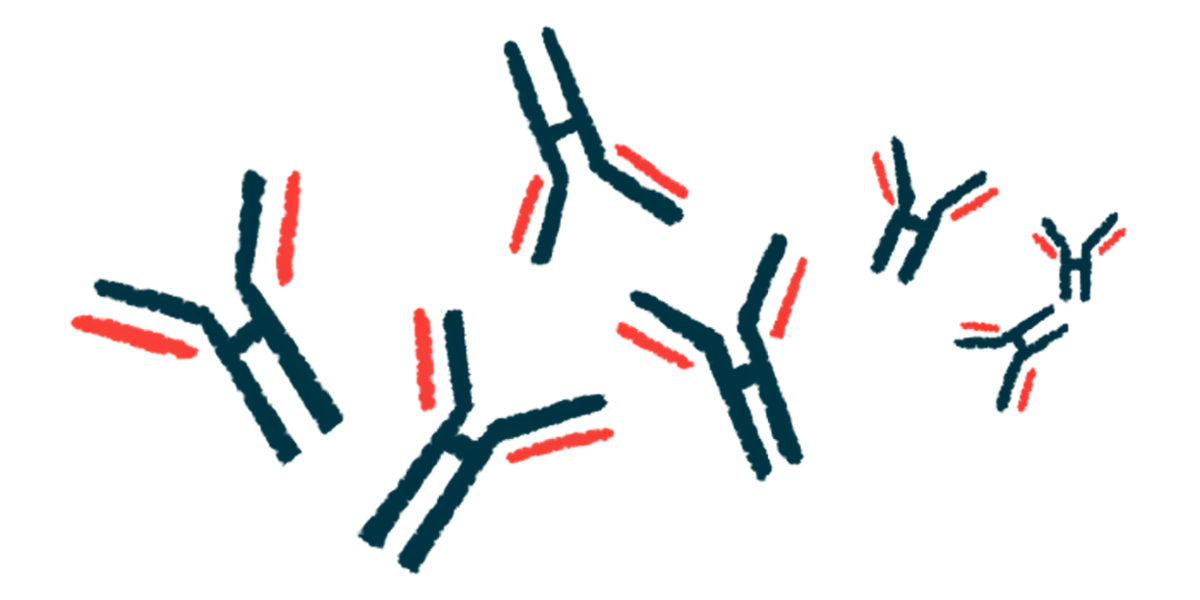New enzyme may disarm antibodies driving myasthenia gravis: Study
S-1117 offers promising approach for treating autoimmune disease

- Myasthenia gravis is driven by self-reactive antibodies (IgG, IgM) attacking acetylcholine receptors.
- Enzyme S-1117 disarms IgG antibodies, reducing complement activation in myasthenia gravis.
- Some patients require combined IgG/IgM-targeting enzymes, highlighting the need for personalized myasthenia gravis treatment.
An enzyme, called S-1117, can disarm self-reactive immunoglobulin G (IgG) antibodies targeting the acetylcholine receptor (AChR) that drive most cases of myasthenia gravis (MG), according to a study that used blood samples from patients.
“This study presents S-1117, an IgG-specific protease [a protein-degrading enzyme], as a promising therapeutic approach for the treatment of acetylcholine receptor-positive myasthenia gravis (AChR-MG),” researchers wrote.
In a small subset of patient samples where S-1117 proved less effective, researchers found evidence of another type of antibodies — anti-AChR IgMs — that may play a similar role to anti-AChR IgGs in fueling the immune response that drives the disease. Using an IgM-targeting enzyme, alone or in combination with S-1117, effectively suppresses the antibody-induced immune responses in this subgroup of patient samples.
“Our study shows that targeting both IgG- and IgM-mediated mechanisms with therapeutic proteases provides an approach to MG treatment and establishes a framework for patient stratification based on disease mechanisms, advancing precision medicine in MG,” the researchers wrote, while emphasizing that further studies are needed to confirm these findings.
The study, “Therapeutic IgG- and IgM-specific proteases disarm the acetylcholine receptor autoantibodies that drive myasthenia gravis pathology,” was published in PNAS by a team of researchers in the U.S.
Self-reactive antibodies target the AChR protein in most cases
MG is an autoimmune disorder in which self-reactive antibodies, or autoantibodies, target proteins at the neuromuscular junction, the site where nerve cells transmit signals to muscle fibers to trigger voluntary movement. This disruption in nerve-muscle communication leads to the hallmark symptoms of MG.
In most cases, self-reactive antibodies target AChR, a protein at the surface of muscle cells at the neuromuscular junction. The majority of these antibodies are of the IgG type, but MG patients may also exhibit anti-AChR antibodies of other types, including IgM, at lower levels.
By binding to AChRs, these autoantibodies activate the complement system, a part of the immune system that normally helps eliminate infectious agents and other potential threats. When overactivated, however, the complement system can damage healthy tissue.
Although MG treatments such as complement blockers and IgG-targeting therapies have led to significant clinical improvements, “40% to 70% of MG patients are classified as nonresponders,” the researchers wrote.
“Collectively, these findings underscore the necessity of investigating innovative therapeutic strategies that may deliver superior efficacy compared to existing options,” they added.
S-1117 effectively removed Fc region from IgG antibodies
To address this gap, the researchers evaluated the therapeutic potential of S-1117, a protease designed to bind to IgG antibodies and cut them to remove their Fc region, the portion responsible for triggering immune attacks through complement activation.
The researchers first tested the effectiveness and specificity of S-1117 in cleaving AChR-targeting IgG antibodies.
In lab tests, S-1117 was found to effectively remove the Fc region from five lab-made anti-AChR IgGs and from anti-AChR IgGs present in blood samples from 11 people with AChR-MG. Similar results were found for total IgG antibodies.
Notably, S-1117’s capacity to remove the Fc region was independent of whether the antibodies were already bound to AChRs and forming immune complexes.
“This dual activity suggests S-1117 can cleave circulating autoantibodies and disarm immune complexes at [disease] sites, including the neuromuscular junction,” the researchers wrote.
Further tests showed that cleavage of the Fc fragment led to a significant reduction in anti-AChR IgG-mediated complement activation, regardless of whether anti-AChR IgGs from MG patients were already bound to AChR or not.
However, in one patient’s blood sample, the researchers noticed that complement activity persisted even after treatment with S-1117. Further analysis revealed that the non-respondent participant had higher levels of anti-AChR IgMs relative to the other patient samples, suggesting that these IgM autoantibodies were also driving autoimmune responses in this patient.
These findings underscore the distinct yet interdependent roles of IgG and IgM in complement activation, establish the [disease-causing] significance of AChR-IgM in MG, and identify a subset of patients unlikely to benefit from IgG-centered therapies, necessitating tailored treatment strategies.
Additional tests showed that, in the non-respondent participant, treatment with an IgM-targeting protease resulted in a greater decrease in complement activation than S-1117 alone. When both enzymes were combined, complement activation was abolished entirely, confirming that both IgG and IgM autoantibodies contributed to complement activation in this patient.
“Our findings uncover a patient subset characterized by IgM-driven complement activation, for whom IgG conventional-centered therapeutic approaches … may prove insufficient,” the team wrote. The data “challenged the view that IgG is the sole driver of complement activation in MG, revealing a significant role for other [antibody types] —particularly IgM.”
Expanding their analysis to a larger group of 210 people with AChR-MG, the researchers found that 9.5% of them carried AChR-targeting IgM antibodies.
By comparing complement activity after treatment with S-1117 alone, the IgM-specific protease alone, or both enzymes together, the samples in this subset of patients could be grouped into three profiles of antibody-mediated complement activity: IgG-dominant, mixed IgG/IgM, and IgM-dominant.
In an independent group of 85 AChR-positive MG patients, AChR-targeting IgM antibodies were detected in 11.7%. These patients fell only into the IgG-dominant and mixed IgG/IgM categories, with none showing complement activity predominantly driven by IgM.
“These findings underscore the distinct yet interdependent roles of IgG and IgM in complement activation, establish the [disease-causing] significance of AChR-IgM in MG, and identify a subset of patients unlikely to benefit from IgG-centered therapies … necessitating tailored treatment strategies,” the team concluded.








